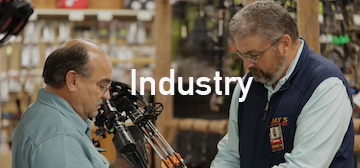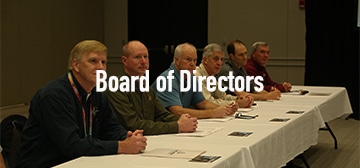<p style="font-weight: 400;">When hunter education courses launched in the U.S. in 1949, most classes were 100% in-person and required paper and field tests. Now, people in most states can pick between online, in-person or blended learning courses. Thanks to improved curriculums and activities, each option provides adequate safety information. However, there’s still a steep learning curve for new hunters, meaning there’s a high demand for educators along the learning continuum.</p>
<p style="font-weight: 400;">ATA members should plug into the world of hunter education to get more people involved, renew their passion for the sport, help newcomers overcome challenges and, most importantly, connect more people to their business.</p>
<h2 style="font-weight: 400;">Education Requirements and Learning Preferences</h2>
https://youtu.be/6v3dHVgHX9A
<p style="font-weight: 400;">Many states require participants to pass a hunter education course before buying a hunting license. Each state wildlife agency has unique rules and requirements for earning a hunter-education certificate. Some states require students to pass a written test and a field test, while others require one or the other. States also administer tests differently. Some let students complete their studies online, while others require in-person meetings and field days taught by qualified instructors.</p>
<p style="font-weight: 400;">Jennifer Davison, hunter education coordinator for the Georgia Department of Natural Resources, said, “No one is going to get more or less from either of the basic classes.” They are all viable options, and the research proves it.</p>
<p style="font-weight: 400;">American hunters had fewer than 500 incidents in the field in 2022; of those, fewer than 30 were fatal. Considering the nation has over 15 million hunters, many of whom hunt daily or weekly, those incident numbers — identified by an International Hunter Education Association study — are a testament to the validity of all hunter education courses.</p>
https://youtu.be/PA8QoQrSBjA
<p style="font-weight: 400;">Additionally, the IHEA completed a <a href="http://find.nationalr3community.org779d5a7c468294f6/original/Effectiveness-of-Hunter-Ed-Delivery-Methods-Final-Report.pdf">2022 study</a> that checked student comprehension and satisfaction across all three education course types. It found comparable test scores and similar student satisfaction levels regardless of the course medium.</p>
<p style="font-weight: 400;">“The takeaway here is that there are audiences for each class option,” said Alex Baer, IHEA executive director. “We don’t want to take away opportunities for people to learn, especially regarding safety. We want that opportunity to remain.”</p>
<p style="font-weight: 400;">Because taking an online, in-person or hybrid course is a personal preference and there’s a desire for each class type, the IHEA, state agencies and industry professionals, including ATA members, must work to provide adequate options and foster newcomers looking for information about hunting.</p>
<h2 style="font-weight: 400;">Filling in the Gaps</h2>
https://youtu.be/89wda9gcELM
<p style="font-weight: 400;"><strong>
</strong>Baer said there was a 35% drop in active volunteers in 2021 from 40,000 to about 27,000 nationally, with a slight increase in the past year. But before you sign up to get certified, Davison encourages ATA members to verify there’s a need.</p>
<p style="font-weight: 400;">According to the IHEA, over 550,000 people graduated from hunter education in 2022, and 295,000 participants took the online course. In Georgia, over 16,000 people took hunter education online and over 1,000 took it in person in 2022.</p>
<p style="font-weight: 400;">The industry doesn’t need more hunter education instructors than there are students. Davison said there will always be a need for in-person classes and instructors but if the ratios are off, people can volunteer in other ways and have a greater impact.</p>
<p style="font-weight: 400;">Baer agrees. “We must rethink how we help states and individuals,” he said. “<a href="https://find.nationalr3community.org/l/7823eda3074381d6/">Research from a few years ago</a>shows that 34% of people who pass a hunter education class don’t buy a license, likely because they don’t know where to start. Hunter education courses teach hunters ethics and how to be safe in the woods, but they don’t cover gear, hunting tactics, how to gain access or where to go, so graduates need more help after passing the course.”</p>
<p style="font-weight: 400;">That’s where all ATA members can get involved along the learning continuum, if they haven’t already.</p>
<p style="font-weight: 400;"><strong>Get Started</strong></p>
https://youtu.be/RcFbwOb9Nu8
<p style="font-weight: 400;">Formal hunter education programs are just the beginning of a hunter’s journey to success and retention. Participants need support every step of the way. Any effort you make to get involved with hunter education helps you renew your spirit, helps you increase business awareness and help others gain confidence as hunters. Working with new hunters also helps you stay up to date on customer needs, habits and preferences. Plug in where you can and where there’s a need. Here are the top options to consider:</p>
<ol>
<li><strong>Become a certified hunter education instructor:</strong> Contact the hunter education administrator in your state to see if there’s a need and understand the requirements. Use <a href="https://archerytrade.org/contact-us/state-contacts/">ATA’s state contact map</a> to find contact information for your state representatives or visit your state wildlife agency website.</li>
<li><strong>Be a host site for a hunter education course or event:</strong> As a hunter education instructor, you can host a certification course at your shop with state approval. Otherwise, simply offering your shop space as a venue helps participants become familiar with your shop and offerings. Ask for a few minutes to greet the attendees and invite them to stay following the event to ask any questions they may have regarding equipment.</li>
<li><strong>Volunteer at existing hunter education courses or events:</strong> Many state agencies need volunteers to help with in-person courses, field days and stand-alone education sessions. For example, the GADNR hosts treestand safety courses. Davison said, “It’d be great to have a pro shop representative bring out new gear and do demonstrations at an event like that.”</li>
<li><strong>Connect with your state wildlife agency: </strong>Introduce yourself to the hunter education administrator in your state so they can refer participants to your business for gear, information, and archery lessons and classes. “It would behoove every ATA member to know who we are and what we do and vice versa,” Davison said. “We want to tie people to a place for next steps.”</li>
<li><strong>Mentor or coach newcomers: </strong>Be a resource for new hunters who have questions about blood trailing, shot placement, etc. You can join or host a formal mentoring program or assist a few people individually.</li>
<li><strong>Join LearnHunting.org for free: </strong><a href="https://www.learnhunting.org/register/">org</a> is a new nationwide communication platform created by the IHEA connects adult hunter education graduates to volunteers in the same geographical area who are willing to share their knowledge about hunting. Baer said over 50% of hunter education graduates are 18 years old or older, meaning they have money, transportation and motivation to start hunting but they typically want guidance and support to get started. Sign up <a href="https://www.ihea-usa.org/resources/#Administrators">here</a>.</li>
</ol>
<p style="font-weight: 400;">Contact <a href="https://archerytrade.org/staff/nicole-nash/">Nicole Nash</a>, ATA’s senior manager of outreach, with questions at nicolenash@archerytrade.org.</p>







